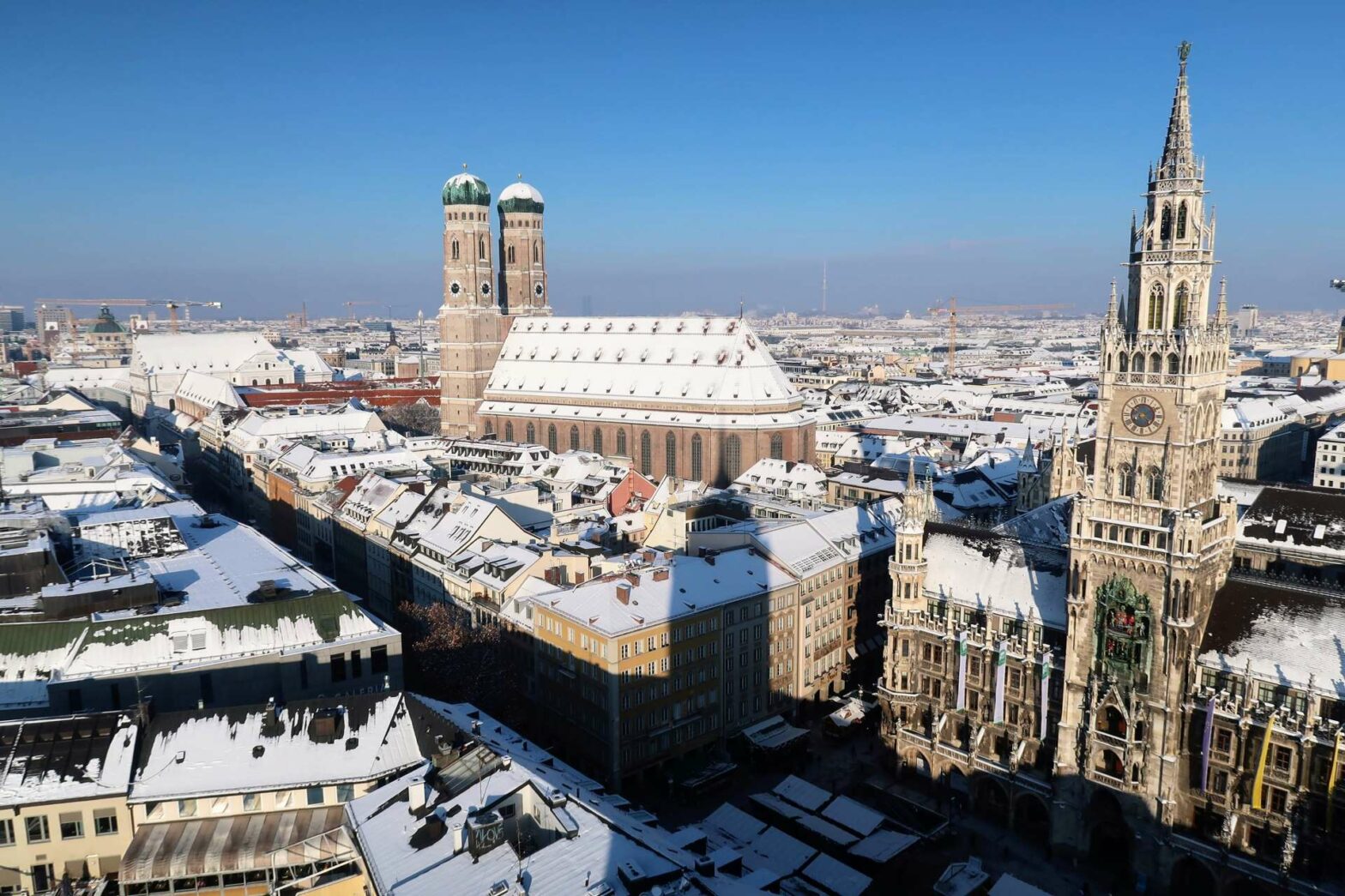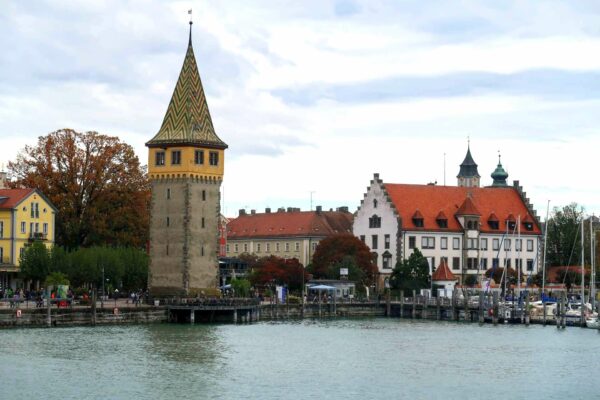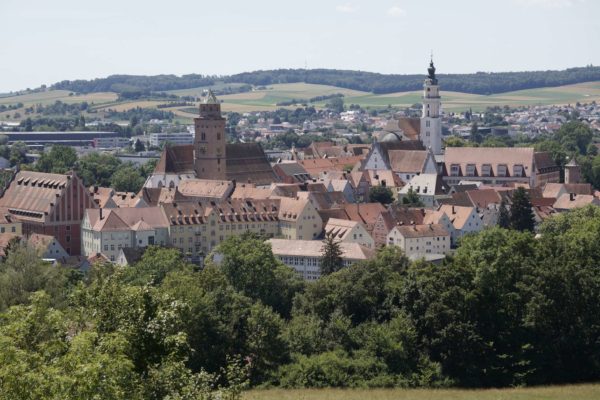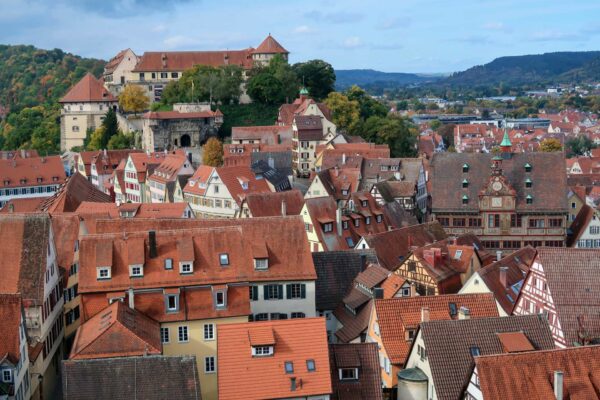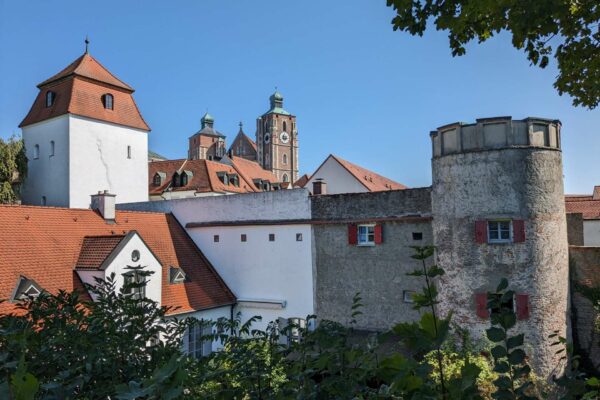By Vicky · Published Dec. 13th, 2023
When you buy through links highlighted with an asterisk (*) on this site, we may earn a small affiliate commission at no cost to you.
Follow this free self-guided walking tour of Munich to explore all the top sights in the atmospheric centre of this grand Bavarian city.
Page Contents:
Location
This walk starts from Karlsplatz, just a few minutes walk from Munich Central Station towards the centre of town. If you’re coming from the airport, you can take an S-Bahn (slow train) or the Lufthansa Express Bus* to the centre of Munich.
Munich Self-Guided Walking Tour Map
Get the route by downloading the .gpx or .kml file below. For navigation with Maps.me on your mobile phone, simply download the .kml file and open to add it to the Maps.me bookmarks.
Tips for Munich Walking Tour
- Many museums cost only €1 on Sundays, and many are also closed on Mondays. Most museums can be booked online in advance, which is worth doing on summer weekends. The museums all have English as well as German information.
- In summer, book lunch and dinner in advance to avoid disappointment.
- Check out other walks on our Germany Hiking Page.
Top Things to Do in Munich
On this self-guided walking tour you’ll see the main sites and attractions of Munich. Two days is the perfect amount of time to spend in Munich, though you could spend twice that time if you want to visit several of the large museums. Munich, with great train connections, also makes a good base for exploring the rest of Bavaria. This is a self-guided walking tour of Munich, if you prefer there’s a great guided walking tour*.
- Neuhauser Straße
- Marienplatz
- Frauenkirche
- Residenz Palace
- Odeonsplatz
- English Garden
- St. Peter’s Church
- Viktualienmarkt
- St. Jakobs Platz
- Asamkirche
- Museum Quarter
Munich Walking Tour Route
This walking tour starts from Karlsplatz, a semi-circular square surrounded by fancy buildings.
1. Neuhauser Straße
Leave Karlsplatz along Neuhauser Straße, the main street lined by shops, that leads to Marienplatz. You’ll first walk through the impressive Karlstor, a medieval tower dating back to the 14th century. As you head along the street you’ll pass two churches, Bürgersaalkirche and Michaelskirche, on your left. Neither look like typical churches, so you’ll need to keep a lookout so as not to miss them.
The first church is the Bürgersaalkirche (closed Sundays), which has a pinky-orange baroque front with white columns. Inside you’ll find an impressive ceiling, several worthwhile wooden sculptures, and a small, free museum displaying church treasures.
Shortly after the Bürgersaalkirche, you’ll see the Augustiner Stammhaus on your right. This is a famous beer hall serving traditional Bavarian dishes in a rather fancy building with a lovely courtyard.
Michaelskirche
Key Information: Free entry to the church, €2 to see the crypt. Closed on Sundays.
Michaelskirche* also has a very distinctive front – white with pink cavities housing statues of the Wittelsbach dynasty (the family that included the Fairytale King Ludwig II). It doesn’t really look like a church at all. You can see the tombs of several Wittelsbach members, including King Ludwig II, in the crypt.
Directions: Continue along Neuhauser Straße and you’ll soon reach the large, busy square of Marienplatz.
2. Marienplatz
Marienplatz is Munich’s main square and it’s always bustling with locals and tourists. It’s the centre of Munich old town and also the centre of the pedestrianised shopping district. There’s a nice fountain in the centre, and a very impressive Gothic town hall (Neues Rathaus) on the northern side. There are also many (slightly overpriced) cafes and restaurants surrounding the square.
Neues Rathaus
The Neues Rathaus (Town Hall) is an incredibly impressive 19th building and also the location of the main Tourist Information Centre. There’s also a famous clock, or Glockenspiel on the Rathaus with a set of figures that revolve and enact a play on certain hours – 11am, noon and 5pm. If you want to know what’s going on – it’s a joust between a Bavarian and a French knight and the display lasts roughly 10 minutes.
Directions: Walk through the courtyard in the centre of the town hall and leave via the left exit. Continue to the obvious church in front of you.
3. Frauenkirche
Key Information: Free entry.
The Frauenkirche* is a 15th-century cathedral famous for its domed towers, and its outline is a symbol of Munich. The name Frauenkirche means ‘Woman’s Church’ and it’s dedicated to the hard work of the women who helped to reconstruct the city after the Second World War. The interior is fairly plain, but the stained glass windows are worth taking a look at and there’s also a small crypt to discover.
Directions: Head back towards the town hall and turn left on the pedestrianised street just before it to reach another square.
4. Odeonsplatz
The Odeonsplatz is an elegant square that often hosts events. You’ll see the Feldherrnhalle (General’s Hall) commemorating Bavarian military leaders and a yellow church on your left.
Theatinerkirche St. Kajetan
Key Information: Free entry.
The Theatinerkirche St. Kajetan* is a big yellow church with a rococo facade and two yellow towers. The interior is rather stunning, with great carvings and paintings. The church was built in the 17th century in an Italian Baroque style, and it was inspired by a church in Rome.
Directions: Take the first left to reach Wittelsbacherplatz, a square surrounded by elegant palaces. Return back to Odeonsplatz and across the other side into the Hofgarten. Cross over the other side and under the road into the English Garden.
5. English Garden
The English Garden* is one of the largest urban parks in the world. You can walk through the garden for as long as you want – it extends over 5 km northward from where you enter. Some of the highlights include the Monopteros (Greek Pavillion on top of a hill) and the Chinese Tower (Chinesischer Turm). This tower also has a Biergarten just next to it, a great place to relax any time of the day.
Not to miss at the southern end of the park is the Eisbach Surfing Wave*. This is an artificial continuous wave and you can spend a while here watching the locals practice their surfing techniques come rain or shine!
The Haus der Kunst (House of Art) is a grand museum next to the surfing wave. It hosts temporary art exhibits, so check the website for what’s on if you’re interested.
Directions: Cross over the road at the Haus der Kunst and walk along the road by the Bavarian State Chancellery – a fancy building with columns and a lot of glass. Just after this building turn right and then left. At the T-junction turn right and you’ll soon be at the courtyard outside the Residenz Palace.
6. Residenz Palace
Key Information: Open daily 9am-6pm in summer, 10am-5pm in winter. There are separate tickets for the Residence Museum (€9), the Treasury (€9) and Cuvilliés Theatre (€5), or you can visit all three for €17. With your ticket, you get a free audio guide.
The Residenz Palace (Website, TripAdvisor Reviews*) is a huge former royal palace with opulent rooms, courtyards, and gardens. The rulers of Bavaria governed and lived here from around 1500 up to the First World War. Today the palace is split into three areas: the Residence Museum, the Treasury and Cuvilliés Theatre, each with its own ticket or visited together with a combination ticket. If you don’t plan to spend a long time here, the Residence Museum is the one to visit.
The Residence Museum covers the main area of the palace, and you can walk through room after highly decorated room. The audioguide describes every single room and it would take many hours to listen to every entry, so skip the ones you aren’t interested in.
The Treasury, as the name suggests, shows off some of the treasures that the owners of the Residence acquired. There’s a lot of bling and again it’s quite large. You can see sculptures, crowns and much more, often made of gold and covered in jewels.
The Cuvilliés Theatre is a very over-decorated theatre full of intricate carvings with gold everywhere. It’s very impressive, but doesn’t take long to see and is perhaps not worth the entry fee unless you get the combined ticket.
Directions: Leave the square along the Residenzstraße and take the first left along a small street to reach a little square.
The famous Hofbräuhaus is on this square, one of Munich’s oldest beer halls. It’s an iconic place to try traditional Bavarian food and beer but can be very busy in summer months.
Directions: Continue through the square then take a right and a left, heading towards the tall church.
7. St. Peter’s Church (Alter Peter)
Key Information: The church and tower are open every day, from 12:00 am to 4:30 pm. Entry to the church is free but climbing the tower costs €5/3 per adult/concession.
St. Peter’s Church* is the oldest church in Munich, dating from the 11th century. The interior of the church is beautifully decorated with an amazing painted ceiling, and don’t miss the golden Baroque high altar with its figure of St. Peter.
Although the inside of the church is worth seeing, most people visit the church to climb the tower. There are panoramic views of the city from the top if you’re up for a bit of exercise and are okay with narrow stairs. There are a few places to rest on the way up, and from the top of the tower, you get perhaps the best view of Munich. You can see the front of the Rathaus, many rooftops and church spires, and if it’s clear, you may even be able to see the Alps in the distance.
Directions: Head into the large market, on the opposite side of the church to Marienplatz.
8. Viktualienmarkt
The Viktualienmarkt is a bustling food market, the largest and most famous marketplace in the city. Here you can sample Bavarian specialties and enjoy a beer at one of the beer gardens while watching the world go by. There are many small vendors selling all kinds of fresh produce and ready-to-eat food, as well as a few selling souvenirs.
Directions: Leave the market on the opposite side and then turn right to walk through the pedestrianised square.
9. St. Jakobs Platz
There are two museums in St. Jakobs Platz, which is a pleasant square containing several cafes.
Munich City Museum
Key Information: Open Tuesday to Sunday, 10 am to 6 pm. Tickets are €6/3 for adults/concessions, and children are free.
The Munich City Museum, or Münchner Stadtmuseum, is a large museum that covers everything to do with Munich, including the rise of Hitler. The captions are in German but there’s an English audioguide to some sections.
Jewish Museum
Key Information: Open Tuesday to Sunday, 10 am to 6 pm. Tickets are €6/3 for adults/concessions, and children are free.
The Jewish Museum and adjacent modern synagogue are in the middle of an open square near the Viktualienmarkt. Exhibits cover the history of Jewish people in Munich. It’s quite a small museum, mainly showing photographs with adjacent text (in German and English).
Directions: Head across St. Jakobs Platz and across the road on the other side. Continue up the small street until you reach a much larger pedestrianised street. Turn left and the church is on your right.
10. Asamkirche
Key Information: Free entry.
The Asamkirche is an 18th-century baroque chapel. It’s quite small, but the interior is intricately decorated in a rococo style. Although the inside is striking, it’s easy to miss when walking past! Make sure to look out for the columns and vertical yellow stripes, and the entrance is in the middle. It’s one of the most impressive churches in Munich.
Directions: Continue walking along the street until you reach Sendlinger Tor, an impressive restored gate from the 14th century. There’s both a tram and a metro (U-Bahn) stop here so you can whizz around Munich. To reach the Museum Quarter, take the tram to Pinakotheken, an 8-minute journey.
11. Museum Quarter
The Museum Quarter contains many museums, but there are also several worthwhile museums outside of this area (see below). The most noteworthy museums in the Museum Quarter are:
- Alte Pinakothek – Old European paintings
- Neue Pinakothek – Paintings from the 18th century onwards
- Pinakothek der Moderne – Contemporary and modern art
- Museum of Egyptian Art – Egyptian artefacts
- NS-Dokumentationszentrum – Munich in the World Wars
- Königsplatz – Greek and Roman antiquities
Alte Pinakothek
Key Information: Open Tue-Sun 10am-6pm (until 8 pm Tue & Wed). Tickets cost €9/6 or €1 on Sundays, children under 18 always free.
The Alte Pinakothek (Website, Tripadvisor Reviews*) is one of the best art museums in Munich and one of the most renowned art museums in the world. In particular, it’s known for its extensive collection of European paintings from the Middle Ages to the Baroque period (14th-18th centuries). There are works by renowned artists such as Albrecht Dürer, Leonardo da Vinci, Raphael, Titian, Rembrandt, Rubens, and many others.
The museum was founded in 1836 by King Ludwig I of Bavaria to house the Bavarian royal family’s extensive art collection, which had been accumulated over several centuries. The building itself is also a work of art, with a neoclassical façade and a majestic entrance.
Neue Pinakothek
Key Information: Currently undergoing a major renovation, scheduled to reopen only in 2029.
The Neue Pinakothek displays works of art from after the 18th century, continuing on from the Alte Pinakothek. There are great paintings by Van Gogh, Monet and many more famous artists here, all in a lovely building. While the museum is closed, some of the best pieces are being displayed in the Alte Pinakothek.
Pinakothek der Moderne
Key Information: Open Tuesday to Sunday, 10 AM to 6 PM, with late night opening hours until 8 PM on Thursdays. Tickets are €10, or €1 on Sundays, children are always free.
The Pinakothek der Moderne is a large museum housing contemporary art. The exhibits are very diverse and most are interesting, with sections on everything from industrial design to robotics to famous Picasso paintings. The architecture of the building itself is also interesting.
Munich Museum of Egyptian Art
Key Information: Open Tuesday to Sunday, 10 AM to 6 PM, with late night opening hours until 8 PM on Tuesdays. Tickets are €7, or €1 on Sundays, children are always free.
The Munich Museum of Egyptian Art has a great collection of Egyptian artefacts and is a real hidden gem in Munich. The museum building itself has an architecturally impressive design, and the layout of the exhibits is also very well thought out. The exhibits cover the time from 5000 years ago all the way to several hundred years ago, not stopping with the Ancient Egyptians like most Egyptian museums. The entrance can be hard to find – it’s the small dark space at the bottom of the wide concrete steps.
NS-Dokumentationszentrum Munich
Key Information: Open Tuesday to Sunday, 10 AM to 7 PM. Free entry.
The NS-Dokumentationszentrum Munich tells the story of Munich during the First and Second World Wars. The exhibits are well laid out, and there’s lots to read as well as watch so you could easily spend a few hours here.
Königsplatz
Königsplatz is a square that looks quite out of place, surrounded by Ancient Greek-style buildings and with a triumphal arch. On the north side is the Glyptothek, a museum of ancient Greek and Roman sculpture. While on the south side is the State Collections of Antiquities.
Other Museums in Munich
Apart from those in the Museum Quarter, there are several other notable museums in Munich, listed below.
Deutsches Museum
Key Information: Open daily from 9am to 5pm. Tickets cost €15/8 for adults/children, with discounts for families. There’s a restaurant, a cafe and kiosks in the museum for refreshments. Buy tickets online on summer weekends. All captions are in both English and German.
The Deutsches Museum (Website, Tripadvisor Reviews*) is one of the world’s largest science museums. You could spend almost an entire day here if you want to see everything, or if you have just a few hours, plan to focus on just a couple of exhibitions. The exhibits include historic aircraft, music, health, robots, mining, bridges and a lot more. It’s a great museum for kids, and there’s an entire children’s zone downstairs where they can be kept amused for hours.
Olympia Park
Olympia Park is a large park to the northwest of the city centre, developed to hold the 1972 Olympics. Today you can visit the Olympic Stadium (€3.50), and even tour the rooftop and bungee jump off the roof. There’s also a tall tower, the Olympiaturm, which you can go up to admire the views. Alternatively, there are a couple of hills within the park that you can walk up for similar views. If it’s a clear day you can see the Alps!
BMW Welt & Museum
Key Information: BMW Welt (BMW World) is free, but you have to get tickets to the BMW Museum (€10). BMW Welt is open from 7:30am to midnight Mon-Sat, and from 9am on Sundays. The BMW Museum is open Tue-Sun 10am to 6pm.
At the BMW complex (Website, Tripadvisor Reviews*) are BMW Welt and the BMW Museum. BMW Welt is free to look around and displays shiny new cars as well as older models and motorbikes. BMW owns Mini and Royles Royce amongst others, so you’ll also see lots of these brands here. It’s quite fun to visit, even if you don’t really care about cars.
You have to pay for the BMW Museum, which is across the covered bridge from BMW Welt. The museum is more about the technical development of cars and motorbikes, as well as the history of BMW. Tours of the museum in both English and German take place regularly.
What to do in the evening in Munich
There are several great ways to spend an evening in Munich, from traditional breweries to concerts and evening walking tours:
- Sample Bavarian food and beer*
- Go to a concert at the Munich Residenz*
- Tour the old town with a nightwatchman*
For more walking tours and hikes in Germany, see our Germany hiking page.

